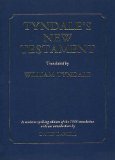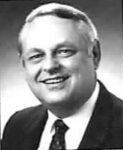Tyndale’s New Testament. Translated from the Greek by William Tyndale. Edited and introduced by David Daniell. New Haven and London: Yale University Press, 1989. 429 pp. Cloth, $28.95.
King Henry VIII’s Chancellor “for all seasons,” Sir Thomas More, called Tyndale “a beast,” one of the “hell-hounds that the devil bath in his kennel,” discharging a “filthy foam of blasphemies out of his brutish mouth,” and more of the same. Stripped down to bare facts, Tyndale’s crime consisted of translating ekklēsia as congregation (not “church”), agapē as love (not “charity”), metanoeō as repent (not “do penance”), and presbyteros as elder (not “priest”). All of Tyndale’s translations are accurate, as any first-year Greek student knows. The bishop of London had given More permission to read the NT in English (forbidden by the “Constitutions of Oxford,” 1408) with the very purpose of discrediting the man and his ministry. The bishop’s seeking out and burning of these New Testaments bordered on the rabid and inquisitorial.
David Daniell, the editor of this large-size (10¾ by 8 inches) volume begs to differ in his evaluation of Tyndale as a translator:
William Tyndale’s Bible translations have been the best-kept secrets in English Bible history. Many people have heard of Tyndale: very few have read him. Yet no other Englishman—not even Shakespeare—has reached so many (p. vii, italics supplied).
This last remark takes on more color when we realize that Daniell has a Ph.D. in Shakespeare and has published widely about the Bard of Avon. He demonstrates that much of the King James NT is pure Tyndale (some, not Daniell, say 90%) and that this is never acknowledged in “The Translators to the Reader” prefacing the 1611 version.
Yale’s splendid reprint of the definitive 1534 Tyndale NT consists of the following: a fascinating 36-page introduction, a short glossary of really difficult terms (such as Candy [=Crete!], liefer, noosel, pyght, stem, and witesafe); 429 pages consisting of two introductions by Tyndale himself, the complete text of the 1534 NT in modern spelling and Roman type (easy to read!), Tyndale’s prologues to the books, his marginal notes, a selection of readings of the church year from the OT (showing Tyndale’s great skill with Hebrew and poetry), a table of Epistles and Gospels, and finally a page of explanations of words such as Gehenna, “added to fill up the leaf withal.” Quite a volume.
Daniell illustrates the great linguistic genius of Tyndale and how his style is truly English, and not filled with the flowery “Latinate” phraseology that so marred the Douay-Rheims Version, to a lesser extent the Bishops Bible, and even on occasion the Authorized Version. While Tyndale sought to reach the boy “that driveth the plough,” he could be powerful and elegant where the original is—such as in Romans and Hebrews. The translator was not some homely unlettered genius, as some have averred, but spoke at least several languages fluently and was a master of Greek and Hebrew, the latter rare talents in the 1520’s and 1530’s. In spite of his very cultural gifts in classical and continental tongues, Tyndale manfully resisted the temptation to show them off in his NT.
Tyndale’s first edition, 1525 or 1526 (only two copies escaped the flames of the Inquisition, which the translator himself did not) is the first printed English NT in history. This should be enough to make Tyndale famous if that was all that he ever did. There is a Tyndale Press, a Tyndale series of commentaries, statues of the translator, and a number of theological schools named after the martyred translator—all welldeserved honors. Until you actually read his translation, however, you cannot know how great was his contribution to evangelical life and letters. In the reviewer’s recently published book—The New King James: In the Great Tradition (Thomas Nelson)—a whole section is devoted to Tyndale’s amazing legacy. No better way exists to show how correct Daniell’s evaluation is than to compare Tyndale, King James, and the New King James to demonstrate how much of his work is still current. The archaic spelling is retained for historical interest. (It also shows the need for this Yale reprint in modern spelling!)
| Tyndale (1526) | KJV (1611) | NKJV (1985) |
| AND he sayde vnto hys disciples: Lett nott youre hertes be trebled. Beleve in God and beleve in me. | 1 Let not your heart be troubled: yee beleeue in God, beleeue also in me. | 1 “Let not your heart be troubled; you believe in God, believe also in Me. |
| In my fathers housse are many mansions. If it were not soo/ I wolde have tolde you. I goo to prepare a place for you. | 2 In my Fathers house are many mansions; if it were not so, I would haue told you: I goe to prepare a place for you. | 2 “In My Father’s house are many mansions; if it were not so, I would have told you. I go to prepare a place for you. |
| I will come agayne/ and receve you even vnto my selfe/ that where I am/ theare maye ye be also. | 3 And if I goe and prepare a place for you, I will come againe, and receiue you unto my selfe, where I am, there ye may be also. | 3 “And if I go and prepare a place for you, I will come again and that receive you to Myself; that where I am, there you may be also. |
| And whither I goo ye knowe/ and the waye ye knowe. | 4 And whither I goe yee know, and the way ye know. | 4 “And where I go you know, and the way you know.” |
| Thomas sayde vnto him: Lorde we knowe not whyther thou goest. Also how is it possible for vs to knowe the waye? | 5 Thomas with unto him, Lord, we know not whither thou goest: and how can we know the way? | 5 Thomas said to Him, “Lord, we do not know where You are going, and how can we know the way?” |
| Iesus sayd vnto him: I am the waye/ verite/ and lyfe. Noman cometh vnto the father/ but by me. | 6 Iesus saith unto him I am the Way, the Trueth, and the Life: no man commeth unto the Father but by mee. | 6 Jesus said to him, “I am the way, the truth, and the life. No one comes to the Father except through Me. |
Theologically Tyndale was a strong Protestant, heavily indebted to Luther, but not as clear on grace at times. GES supporters who read this reprint will notice the strains of legalism in the translator’s notes and introductions, as does Daniell:
Though [the first preface] begins with a ringing sentence, it is not quite like his usual explanation of the law and the gospel, being more concerned with declaring that the key to understanding the New Testament is the “covenant” made between God and man. It seems to a modern eye not quite the expected Reformers’ liberation: “All the promises of the mercy and grace that Christ bath purchased for us are made upon that condition that we keep the law.” Later he swings to the classic Protestant emphasis on faith: “Faith unfeigned in Christ’s blood causeth to love for Christ’s sake” (p. xv).
Tyndale’s apparent vacillation between law and grace might suggest that he was more talented as a translator than as a theologian. At any rate, this reviewer (and I feel sure most of our readers) prefers Tyndale in his “grace mode,” to say the least.
Who should get this book? Obviously all libraries and advanced schools, but also all lovers of the Bible, Bible translation work, church history and biography, the English language, and the Reformation.
Except for some almost inevitable typographical errors in a work of this size and such trivial faults as bible lower-cased on the dust jacket (oddly capitalized when used as an adjective on the same back flap), this is a fine piece of work. Get one.
Arthur L. Farstad
Editor
Journal of the Grace Evangelical Society
Dallas, TX


